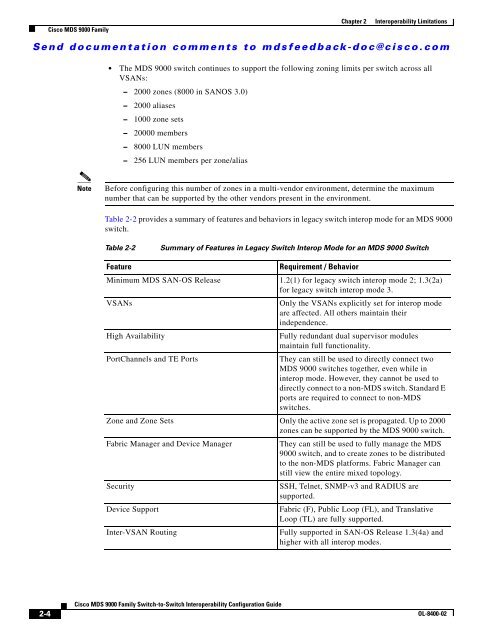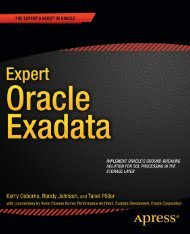Cisco MDS 9000 Family Switch-to-Switch Interoperability ...
Cisco MDS 9000 Family Switch-to-Switch Interoperability ...
Cisco MDS 9000 Family Switch-to-Switch Interoperability ...
Create successful ePaper yourself
Turn your PDF publications into a flip-book with our unique Google optimized e-Paper software.
<strong>Cisco</strong> <strong>MDS</strong> <strong>9000</strong> <strong>Family</strong><br />
Chapter 2<br />
<strong>Interoperability</strong> Limitations<br />
Send documentation comments <strong>to</strong> mdsfeedback-doc@cisco.com<br />
• The <strong>MDS</strong> <strong>9000</strong> switch continues <strong>to</strong> support the following zoning limits per switch across all<br />
VSANs:<br />
– 2000 zones (8000 in SANOS 3.0)<br />
– 2000 aliases<br />
– 1000 zone sets<br />
– 20000 members<br />
– 8000 LUN members<br />
– 256 LUN members per zone/alias<br />
Note<br />
Before configuring this number of zones in a multi-vendor environment, determine the maximum<br />
number that can be supported by the other vendors present in the environment.<br />
Table 2-2 provides a summary of features and behaviors in legacy switch interop mode for an <strong>MDS</strong> <strong>9000</strong><br />
switch.<br />
Table 2-2<br />
Summary of Features in Legacy <strong>Switch</strong> Interop Mode for an <strong>MDS</strong> <strong>9000</strong> <strong>Switch</strong><br />
Feature<br />
Minimum <strong>MDS</strong> SAN-OS Release<br />
VSANs<br />
High Availability<br />
PortChannels and TE Ports<br />
Requirement / Behavior<br />
1.2(1) for legacy switch interop mode 2; 1.3(2a)<br />
for legacy switch interop mode 3.<br />
Only the VSANs explicitly set for interop mode<br />
are affected. All others maintain their<br />
independence.<br />
Fully redundant dual supervisor modules<br />
maintain full functionality.<br />
They can still be used <strong>to</strong> directly connect two<br />
<strong>MDS</strong> <strong>9000</strong> switches <strong>to</strong>gether, even while in<br />
interop mode. However, they cannot be used <strong>to</strong><br />
directly connect <strong>to</strong> a non-<strong>MDS</strong> switch. Standard E<br />
ports are required <strong>to</strong> connect <strong>to</strong> non-<strong>MDS</strong><br />
switches.<br />
Zone and Zone Sets Only the active zone set is propagated. Up <strong>to</strong> 2000<br />
zones can be supported by the <strong>MDS</strong> <strong>9000</strong> switch.<br />
Fabric Manager and Device Manager<br />
Security<br />
Device Support<br />
Inter-VSAN Routing<br />
They can still be used <strong>to</strong> fully manage the <strong>MDS</strong><br />
<strong>9000</strong> switch, and <strong>to</strong> create zones <strong>to</strong> be distributed<br />
<strong>to</strong> the non-<strong>MDS</strong> platforms. Fabric Manager can<br />
still view the entire mixed <strong>to</strong>pology.<br />
SSH, Telnet, SNMP-v3 and RADIUS are<br />
supported.<br />
Fabric (F), Public Loop (FL), and Translative<br />
Loop (TL) are fully supported.<br />
Fully supported in SAN-OS Release 1.3(4a) and<br />
higher with all interop modes.<br />
2-4<br />
<strong>Cisco</strong> <strong>MDS</strong> <strong>9000</strong> <strong>Family</strong> <strong>Switch</strong>-<strong>to</strong>-<strong>Switch</strong> <strong>Interoperability</strong> Configuration Guide<br />
OL-8400-02











